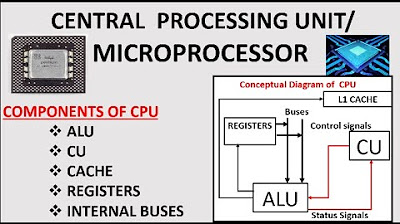Arsitektur Sistem Mikroprosesor
Summary
TLDRThis video tutorial explains the architecture of a microprocessor, emphasizing its key components: the control unit, arithmetic logic unit (ALU), and registers. It differentiates between microprocessors and microcontrollers, highlighting that while a microprocessor requires additional components like memory and I/O to function, a microcontroller integrates all necessary components into a single IC. The video also covers the performance factors of microprocessors, including clock speed, core count, and architecture type (RISC vs. CISC). The concepts are illustrated with analogies to improve understanding, comparing the microprocessor to the brain, memory to a worker’s desk, and I/O to data pathways.
Takeaways
- 😀 A microprocessor is a single-component IC consisting of a control unit, arithmetic logic unit (ALU), and registers.
- 😀 A microprocessor cannot operate on its own; additional components are needed to form a complete computer architecture.
- 😀 The architecture of a microprocessor includes ICs for memory, with all components interconnected to form a system.
- 😀 When microprocessor components are embedded in a single IC, it is referred to as a microcontroller.
- 😀 A microcontroller differs from a microprocessor because it includes all the necessary architecture to perform tasks independently.
- 😀 The term 'microprocessor system' refers to a microprocessor equipped with the necessary architecture to perform specific tasks.
- 😀 I/O components and buses are crucial for data transfer in a microprocessor system, facilitating communication between components.
- 😀 Memory in a microprocessor system consists of registers that store binary data, with the system's performance increasing as memory capacity grows.
- 😀 The performance of a microprocessor system is influenced by factors like clock speed (higher is better), number of cores (more cores improve performance), and architecture (CISC vs RISC).
- 😀 The performance of a microprocessor can be visualized by comparing it to the brain's speed and capacity to process tasks, where more 'brains' (cores) or a larger 'desk' (memory) speed up performance.
- 😀 The efficiency of I/O systems and bus configurations impacts the overall speed of a microprocessor system, with better configurations leading to faster operations.
Q & A
What is the main difference between a microprocessor and a microcontroller?
-A microprocessor is a single IC component that requires additional components, such as memory and I/O systems, to perform tasks. A microcontroller, on the other hand, integrates a complete architecture, including memory and I/O, allowing it to operate independently.
Why can't a microprocessor function alone without additional components?
-A microprocessor lacks the necessary memory and I/O components, which are essential for storing data and enabling communication between the microprocessor and external devices. These additional components are required for it to perform tasks effectively.
How do memory and bus components affect the performance of a microprocessor system?
-Memory is made up of registers that store binary data, and a wider bus allows faster data transfer. The more structured the memory and bus components are, the faster the processing speed of the system.
What role does I/O and bus components play in the functionality of a microprocessor?
-I/O and bus components facilitate the movement of binary data (either data or addresses) within the system. Efficient pathways for data flow, as well as better branching and control, result in a faster processing system.
What is the significance of clock speed in a microprocessor?
-Clock speed, measured in hertz (Hz), determines how fast a microprocessor can process data. Higher clock speeds enable faster operations, improving the overall performance of the microprocessor.
How does the number of cores in a microprocessor affect its performance?
-The more cores a microprocessor has, the more tasks it can handle simultaneously. This increases the processing speed and performance of the microprocessor system, particularly for multi-threaded tasks.
What are the two primary microprocessor architectures mentioned in the transcript, and how do they differ?
-The two architectures mentioned are CISC (Complex Instruction Set Computing) and RISC (Reduced Instruction Set Computing). RISC simplifies instructions, making the system faster, whereas CISC uses more complex instructions, often resulting in slower performance.
What is the analogy used to describe the performance of a microprocessor?
-The performance of a microprocessor is compared to the brain of a worker: the better the brain (processing power) and skills, the faster the tasks are completed. Similarly, more 'brains' (cores) lead to faster performance.
How is memory described in terms of performance in the transcript?
-Memory is likened to the size of a worker’s desk: a larger desk (larger memory) allows for faster work (processing) to be done, as there is more room for data to be processed and stored.
What does the bus component represent in the analogy given in the transcript?
-The bus is compared to the efficiency of pathways between workers: the broader and smoother the pathways, the faster the work (processing) can be done, representing the speed of data transfer within the system.
Outlines

此内容仅限付费用户访问。 请升级后访问。
立即升级Mindmap

此内容仅限付费用户访问。 请升级后访问。
立即升级Keywords

此内容仅限付费用户访问。 请升级后访问。
立即升级Highlights

此内容仅限付费用户访问。 请升级后访问。
立即升级Transcripts

此内容仅限付费用户访问。 请升级后访问。
立即升级浏览更多相关视频

CPU and Its Components|| Components of MIcroprocessor

Informatika kelas 9 Unit Pengolahan Logika dan Aritmatika

GCSE Computer Architecture 1 - Von Neumann Architecture

Media Pembelajaran : Struktur dan Fungsi CPU

2. Arsitektur Komputer Struktur CPU

IGCSE Computer Science 2023-25 - Topic 3: HARDWARE (1) - COMPUTER ARCHITECTURE - Von Neumann & CPU
5.0 / 5 (0 votes)
